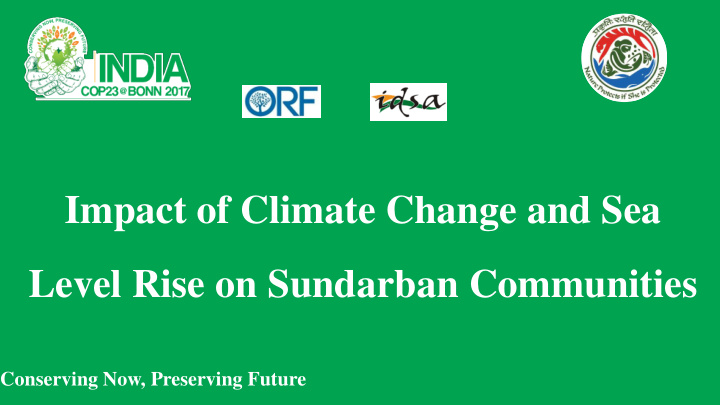



Impact of Climate Change and Sea Level Rise on Sundarban Communities Conserving Now, Preserving Future
Sundarban: Key Features Ecological • Celebrated ecological habitat among the three • largest single tract mangrove forests Most bio-diverse and Most significant Fish Nursery • of the Bay of Bengal The only habitat of the endangered Bengal Tiger • Social • High poverty rates and limited livelihood • opportunities Lowest per capita income and per capita land area • compared to Small Island Developing States (SIDs), more people than 18 SIDs Persistent pressures from sea level rise, salinization • of soil and water, cyclonic storms and flooding Conserving Now, Preserving Future
Coastal Changes: Sea Level Rise and Increase in Salinity • Sea Level Rise • Sagar Island: Sea level rise estimated at 17.8 mm per year between 2001 and 2008, compared to a rise of 3.14 mm per year during the preceding decade • Climate change is only one part of the explanation Compaction of settled lands translating into sinking • land levels Ongoing sedimentation of the estuary • Overarching geomorphological changes of the delta • as a whole • Salinity • Main causes: storm surges and tidal effects. Fresh water supply into the region that counteracts this stands reduced • The Bengal Basin tilting gradually in an eastern direction due to sediment loading and tectonic subsidence • river courses have shifted east central and south-western coast of Bengal, are largely bypassed by the main rivers of the delta, limiting fresh water input Conserving Now, Preserving Future
Cyclonic Storms and Flooding • Sundarban area is cyclone-prone, monsoonal and low-lying Cyclonic Storm Tracks in Bay of Bengal 1891-2007 • More than 4 cyclonic events per year of varying wind forces • Cyclonic storm hitting the Sundarbans area have increased in intensity between 1951 and 2010 • The increase in intensity is attributed to the increase in Sea Surface Temperature • 1891-1994: 90 cyclones (35 severe) • Cyclones alone account for about 45% of all losses in the Sundarban • People exposed to disaster events (2000-10) 92% (83% in India, 99.6% in Bangladesh) Conserving Now, Preserving Future
Adaptation: Preserving Ecosystem for Sustainable Livelihoods • Population increased from about 1 million in the 50s to over 4 million today • Exposure to natural disasters leaves few choices for the people of Sundarban • Migration, change in livelihood • But few consider migration as first choice (film) • State actions: • Preserving mangroves as the first level of defence • Mobilising communities to take action rapidly and cyclone proof themselves • Building up strategies for sustainable use of natural resources • construction of non invasive infrastructure to support sustainable livelihoods • Insurance coverage to the stakeholders of key livelihood sectors Conserving Now, Preserving Future
Conserving Now, Preserving Future
Recommend
More recommend